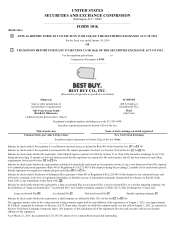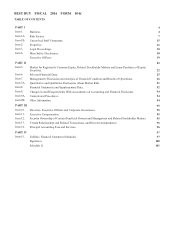Best Buy 2016 Annual Report Download - page 19
Download and view the complete annual report
Please find page 19 of the 2016 Best Buy annual report below. You can navigate through the pages in the report by either clicking on the pages listed below, or by using the keyword search tool below to find specific information within the annual report.11
• the appropriate number of stores in our portfolio;
• the formats and sizes of our stores;
• the locations of our stores;
• the interior layouts of our stores;
• the trade area demographics and economic data of each of our stores;
• the local competitive positioning in and around our stores;
• the primary term lease commitment for each store;
• the long-term lease option coverage for each store;
• the occupancy cost of our stores relative to market rents;
• our supply chain network strategy; and
• our ongoing network of service locations.
If we fail to effectively evaluate these factors, fail to negotiate terms which keep us market competitive, or if unforeseen
changes arise, the consequences could include, for example:
• having to close stores and abandon the related assets, while retaining the financial commitments of the lease;
• incurring significant costs to remodel or transform our stores;
• having stores, supply chain or service locations that no longer meet the needs of our business; and
• bearing excessive lease expenses.
These consequences could have a materially adverse impact on our profitability, cash flows and liquidity.
For leased property, the financial impact of exiting a location can vary greatly depending on, among other factors, the terms of
the lease, the condition of the local real estate market, demand for the specific property, our relationship with the landlord and
the availability of potential sub-lease tenants. It is difficult for us to influence some of these factors and the costs of exiting a
property can be significant. We are still responsible for the maintenance, taxes, insurance, and common area maintenance
charges for vacant properties until the lease commitment expires or is terminated. Similarly, when we enter into a contract with
a tenant to sub-lease property, we usually retain our obligations as the master lessor. This leaves us at risk for any remaining
liability in the event of default by the sub-lease tenant.
Failure to effectively manage our costs could have a material adverse effect on our profitability.
Some of our operating costs are fixed and/or are subject to multi-year contracts. Some elements of our costs may be higher than
our competitors, because, for example, of our differential service offerings or levels of customer service. As discussed above,
our revenues are susceptible to volatility from various sources, which can lead to periods of flat or declining revenues.
Accordingly, our ongoing drive to reduce cost and increase efficiency represents a strategic imperative. Failure to successfully
manage our costs could have a material adverse impact on our profitability and curtail our ability to fund our growth or other
critical initiatives.
Our liquidity may be materially adversely affected by constraints in the capital markets or our vendor credit terms.
We need sufficient sources of liquidity to fund our working capital requirements, service our outstanding indebtedness and
finance business opportunities. Without sufficient liquidity, we could be forced to curtail our operations, or we may not be able
to pursue business opportunities. The principal sources of our liquidity are funds generated from operating activities, available
cash and liquid investments, credit facilities, other debt arrangements and trade payables. Our liquidity could be materially
adversely impacted if our vendors reduce payment terms and/or impose tighter credit limits. If our sources of liquidity do not
satisfy our requirements, we may need to seek additional financing. The future availability of financing will depend on a
variety of factors, such as economic and market conditions, the regulatory environment for banks and other financial
institutions, the availability of credit and our credit ratings and our reputation with potential lenders. These factors could
materially adversely affect our costs of borrowing and our ability to pursue business opportunities, and threaten our ability to
meet our obligations as they become due.
Changes in our credit ratings may limit our access to capital and materially increase our borrowing costs.
Our credit ratings and outlooks at January 30, 2016 are summarized below. In fiscal 2016, Standard & Poor's Rating Services
upgraded its long-term credit rating from BB to BB+ with a Stable outlook. Moody's Investors Service, Inc. upgraded its long-
term credit rating from Baa2 to Baa1 with a Stable outlook. Fitch Ratings Limited upgraded its long-term credit rating from BB
to BBB- with a Stable outlook.
























